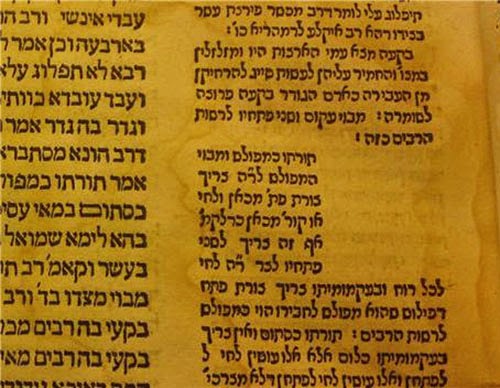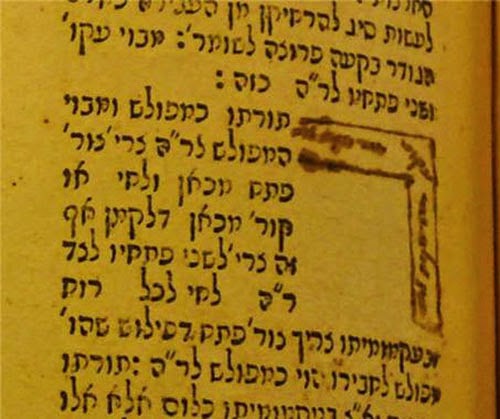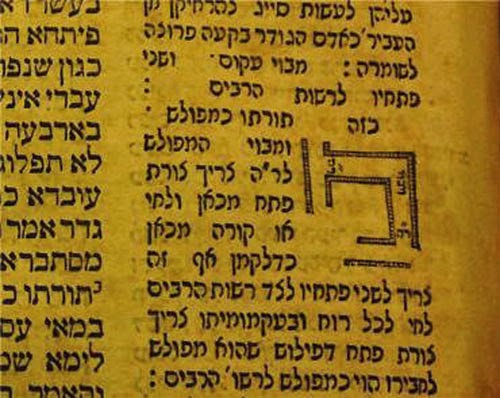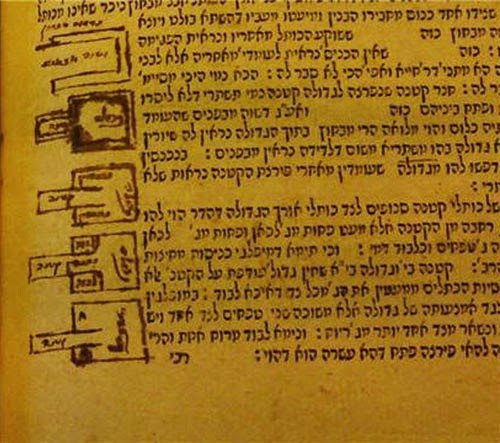A Picture is Worth a Thousand Questions
A PICTURE IS WORTH A THOUSAND QUESTIONS
By Eli Genauer
Authors note: I would like to thank Dr. Peggy Pearlstein and Sharon Horowitz of the Library of Congress for their help in allowing me to assemble the various printed editions of the Talmud that I used in this article
Amongst all the difficult tractates of the Talmud, Eruvin stands head and shoulders above most. The Gemara tries to describe in words what would normally take a picture to understand. Thankfully, our printed editions of Eruvin contain many diagrams, in the body of the text, in Rashi and in Tosafot. These diagrams help us make sense of what is going on. Truthfully, I don’t know how one could learn this Gemara without the diagrams.
I would like to analyze one such diagram and trace its history in the printed editions of Eruvin. At the end of my analysis, I will leave the reader with a few questions to ponder.
The Talmud Bavli, Eruvin, 6A, discusses the case of the מבוי עקום, literally a bent alley.[1] This is a mavoy (alley) shaped like an “L” that opens to the Reshut ha-Rabim at both ends. Indeed, both Rav and Shmuel agree that this mavoy is open on both ends to the Reshut ha-Rabim, but, they disagree on its halachic treatment. As I mentioned, the word ‘akum literally means “bent”. But, how do we know it is actually an “L” shaped mavoy? Probably from this picture which we find in the classic Vilna Shas.
It shows an “L” shaped mavoy with the notation that this mavoy opens up to the Reshut ha-Rabim at each end. Rashi does not say that it is an “L” shaped mavoy, only “מבוי עקום ושני פתחיו לרשות הרבים – a mavoy ‘akum is one that has both of its openings facing the Reshut ha-Rabim. Rashi does, however, add a critical word which adds to our understanding of the term, and that is the word “ka-zeh” (like this, or in this context, as described below). Underneath the word ka-zeh, in the Vilna edition, is the diagram with the “L” shaped mavoy, and now we know how Rashi explains this term in the Gemara. Of course, this assumes that the diagram, as it appears in the Vilna edition, is what Rashi provided. Thus, in order to ascertain if the “L” shaped diagram is really what Rashi intended, we need to examine earlier editions to assure ourselves that this diagram is the correct one.
Let us now turn to the history of the printed editions of the Talmud and, specifically, the various versions of this Rashi in different editions. I first looked at the second Bomberg edition printed in Venice in 1528.[2] Marvin Heller states that the Bomberg editions were, to some extent, based on the previous editions of Gershom Soncino.[3] However, where Soncino editions did contain diagrams, the Bomberg editions did not.[4] Dr. Edward Fram writes that “A blank space was left on the page suitable for adding a woodcut, but, whether for financial or technical reasons, the diagrams were not included until later printings”.[5] It wasn’t until Yissochar Berman Segal’s Frankfurt on Oder edition of 1697-1699, almost 200 years later, that diagrams were included in a printed edition.
The text in Rashi reads מבוי עקום ושני פתחיו לרשות הרבים כזה. The words are perfectly clear, but without a diagram to indicate what the word ka-zeh meant, a student might be a bit lost.
At least the reader would know that there was supposed to be a diagram there, and he might look somewhere else (perhaps in an old Rashi manuscript) to find it.
Such is not the case for our next example, which was printed in Cracow in 1619. This was a smaller version of the Talmud and included only the text of the Gemara and the Rashi. It was printed for students for use in various Yeshivos.[6] Here is how our passage looks there.
If you look at the 7th line on the picture shown, you will see it says מבוי עקום ושני פתחיו לר”ה כזה, but there is no space left to indicate a diagram was supposed to go there. One wonders what went through the mind of a young Yeshiva student when he studied this line. It is perhaps no wonder that Marvin Heller quotes R. Raphael N.N. Rabinowitz comment regarding this edition of Eruvin that “the tractate is almost impossible to learn from, and is, therefore, worthless.”[7]
Next we will go to the Benveniste edition, printed in Amsterdam in 1644. Similarly, this edition does not contain diagrams, as we can see from a copy that I possess.
However, as noted above, there were some editions that had the blank spaces filled in by artists or through the addition of woodcuts. Such is an edition housed in the Library of Congress, where the page in question looks like this.
The words inside the diagram are smudged, but at least it is somewhat clear that the alley in question is “L” shaped.[8]
Let us finally get to the first edition that had diagrams included, that of Frankfurt on Oder of 1697. After almost 200 years of no printed diagrams, just empty spaces, this is what we see.
It is safe to say that the editors belonged to the minimalist group of diagram makers. We can see the “L” shape, but no indication of where the reshut ha-rabim begins. You will also notice that the word מכאן is spelled incorrectly as מיכן, in the text of the Rashi.[9] Not an auspicious start for diagrams in the printed Talmud.
From then on, the diagrams get a little better and begin to look quite a bit like the definitive diagram in the Vilna Shas. Here are a few examples.
DYHERNFURTH 1816
My personal favorite is from Frankfurt on Oder of 1734. I think the picture tells the story best (even better than the Vilna Shas) because of the position of the words “reshut ha-rabim“. (ר”ה as abbreviated)
This edition, correctly shows the reshut ha-rabim beginining only where the alley ends.
As I mentioned before, the Soncino editions contained the diagrams that were missing in the Bomberg editions. (See note [4] below). Clearly, these came from manuscripts which were used to prepare the Soncino editions. It was easy for a scribe who was copying a manuscript to insert a diagram where indicated, as everything was being done by hand. We might also assume that the copyists were artistic in nature and that drawing a diagram came easily to them.
I am left with just a few questions.
1. Who drew the first diagram? Was it Rashi himself? Are there manuscripts that provide evidence that Rashi did or did not execute the diagrams that appear in today’s editions of the Talmud?
2. Did Rashi even write the word “ka-zeh” in his Peirush?
3. Once the original manuscript of Rashi was copied and re-copied, did the diagrams change? I can imagine that a copyist wanted to strictly maintain Rashi’s words, but I wonder if one of them thought that their version of a diagram might be better understood? This would cause later versions to be changed forever.
We know that a picture is worth a thousand words. We are also taught that in studying Gemara, every word is precious. It is therefore very important that the diagrams that we have be accurate, so that the thousand words they tell us will also be accurate.
NOTES
[1] The online Milon gives the following meaning to the word “‘akum” – curved; bent; inclined. Jastrow renders our particular passage as “a winding alley.” Clearly, a picture would be helpful here to indicate what the Gemara was talking about.
[2] Maamar ‘al hadpasat ha-Talmud with Additions, ed. A.M. Habermann, Mossad ha-Rav Kook, Jerusalem: 2006, p. 73 n.1. Rabinowitz states that although it is unclear to him the exact date of the printing of all the volumes of this edition, he had a copy of Eruvin that provided it was printed in [5]288 (1527/8). This is the same year indicated in the copy in the Library of Congress.
[3] Marvin J. Heller’s Printing the Talmud: A History of the Earliest Printed Editions of the Talmud, Brooklyn, NY: 1992, p. 145.
[4] Here is an image of the Soncino, Pesaro 1511 Eruvin 6A which shows a diagram of the “L’ shaped alley (from JNUL online digitized collection). Marvin Heller has a picture of the front page of this Tractate in his above cited book (p. 110) and he identifies it as Pesaro 1511.
[5] Edward Fram, “In the Margins of the Text, Changes in the Page of the Talmud,” in Printing the Talmud: From Bomberg to Scottenstein, ed. Sharon Lieberman Mintz et.al., Yeshiva Univ. Museum, New York: 2005, p. 91, n.4.
[6] Heller id. at p. 38.
[7] Id. p. 388. According to Heller, Rabinowitz made his comment because of the inferior paper and letters of this edition. But, I imagine that he was also bothered by instances such as this.
[9] It was spelled that way in the Pesaro 1511 edition also. I assume that the Vilna Shas version is correct.










